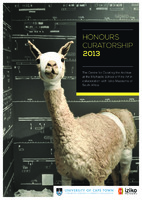Items
Site
The Medicine Chest
keywords is exactly
wife
-

A translated rock
In 2012, while exploring possible curatorial opportunities for the Honours in Curatorship students, I met with Sven Ouzman, a curator in the archeology department at Iziko, to chat about possible opportunities pertaining to this collection. I took him the newly designed course prospectus, to peruse. He flipped through it and when he got to the second last page, he paused. ‘Do you know the story behind this image’, he asked. I told him I didn’t… He pointed at the rock in the bottom right hand corner and started his story. Apparently this rock was not part of the SAN Rock art collection at all. It belonged to an archeologist who worked at the museum for close to twenty years. When she first started at the museum, her partner, now husband (and also an archeologist) also worked there with her. They were still in the beginning of their relationship and he was, to use older terminology, still courting her. One of the gifts he gave her during this period, was a rock he drew that mimicked San rock paintings, probably ones that would pertain to love in some way or other. She kept this in her office and, when she finally left the museum and had to empty her belongings, forgot to pack the rock as well. Exit archeologist, enter the lady who tidied the office before the new occupant moved in. On finding the rock she assumed it was part of the collection and returned it to the store room where it was assimilated into the bona fide rock art collection. I don’t know in how many exhibitions it subsequently appeared, but in 2010 it appeared up in Pippa Skotnes’s exhibition 'Made in translation' – an exhibition that fittingly explored ways in which translations from the landscape have been made and in so doing, placed images of rock art in the context of other forms of translation. -

Echolocation (Part one)
In the spring of 1940, Steinbeck and his very close friend, biologist Ed Ricketts, chartered a boat and embarked on a month long marine specimen-collecting expedition in the Gulf of California, which resulted in their collaboration on a book, 'The Sea of Cortez'. Described as both a travelogue and biological record, it reveals the two men's philosophies: it dwells on the place of humans in the environment, the interconnection between single organisms and the larger ecosystem, and the themes of leaving and returning home. A number of ecological concerns, rare in 1940, are voiced, such as an imagined but horrific vision of the long term damage that the Japanese bottom fishing trawlers are doing to the sea bed. Although written as if it were the journal kept by Steinbeck during the voyage, the book is to some extent a work of fiction: the journals are not Steinbeck's, and his wife, who had accompanied him on the trip, is not mentioned (though at one point Steinbeck slips and mentions the matter of food for seven people). Since returning home is a theme throughout the narrative, the inclusion of his wife, a symbol of home, would have dissipated the effect. Steinbeck and Ricketts are never mentioned by name but are amalgamated into the first person "we" who narrate the log.


